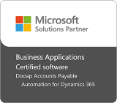
The world of accounts payable is built on thinking in terms of processes. However, the beginning of a new year offers up a rare opportunity to look at things from a different perspective. It’s a collective moment of breath to reflect on what works, what doesn’t and what’s new for the road ahead.
Edit: January 2019 – We reflect on our past predictions and take a look at what the new year is bringing us in our new blog post 2019 Predictions for AP Automation – Major AP Developments Ahead.
For AP professionals, where is that road leading? What are the trends to keep an eye on in the coming year? There isn’t a magic crystal ball with all the answers (yet). But there are several markers pointing in the direction of what’s in store for accounts payable in 2018, and beyond.
E-invoicing in – OCR out
Electronic invoicing is gaining increasing attention in North America. The federal government will officially be moving towards e-invoicing, after the Office of Management and Budget issued a deadline to do so by the end of 2018. Additionally, the Federal Reserve will support a three-year initiative to design an electronic invoice interoperability framework for the U.S. market. These trends will help companies move towards true digitalization and automation of purchase invoices with appropriate software.
Optical Character Recognition (OCR) as a technology will still work alongside automation software, complementing e-invoicing. But with paper and PDF invoice dispatching already decreasing in numbers globally, OCR will eventually become outdated. Instead of investing heavily in an in-house OCR system, cost-conscious companies choose OCR as a service (Capture-as-a-service, CaaS).
Robotics and Machine Learning Take Hold
Many companies still believe they are not big enough to take advantage of robotic process automation (RPA) and machine learning. But that mindset will change quickly in 2018 as access to RPA and machine learning tools become more widely available and cost effective. In the year ahead, mid-size and smaller businesses will be able to reap the benefits of using software robotics to handle repetitive and labor-intensive tasks, particularly the “long tail” of tasks that are not taken care of by traditional automation software. Increasing machine learning capabilities of software will take automation even further; learning by observing humans, the software continuously becomes more intelligent and accurate.
But don’t get too up in arms if you work in AP. RPA coupled with machine learning will tackle the time-consuming tasks where rules can be applied consistently over a set process, freeing AP staff to be more proactive and forward thinking on important issues like cash flows and fraud. Another added benefit is that much of the work done by software robotics can be relegated to off hours, so that those tasks are completed over night and the data is available when employees get to the office in the morning.
Visibility and Control = Influence
Greater control and visibility thanks to automation means AP can have more input and influence in a number of areas in 2018. AP will be empowered to provide CFOs with analytics that can deliver a wealth of useful information on spend including providing data to help pinpoint optimal vendor payment cycles. Nearly impossible before automated and semi-automated environments, the influence of quick and readily available data will increasingly guide CFOs’ decision-making when it comes to vendor selection, payment plans and the benefits associated with paying vendors early, on time, or late.
As the AP environment continues to shift towards more efficiency through automation, businesses are also shifting their attention on what they can improve next. One trend to keep an eye on in 2018 is a movement to analyze and more closely manage working capital, so businesses can make better use of their cash.
Breaking Down Silos with Procurement
Automation of financial processes in the coming years will also help tear down the walls between procurement and accounts payable, creating a more collaborative relationship between the two. For example, an increased ability to accumulate and analyze payments data will allow procurement to make more strategic decisions regarding product expansion, inventory capacity, and choice of suppliers, which could reduce purchasing and other costs.
Chatbots Become More Integrated
Chatbots and digital assistants, like Apple’s Siri, will play a larger role in areas such as expense management. As chatbots become more integrated into services such as Microsoft Azure’s LUIS (Language Understanding Intelligent Service), which aides in natural language understanding and cognitive services, data like travel expenses and billable hours will be captured as they happen by the employee and this will help to streamline the work of AP departments.
Tools Will Become More App-Like
The tools available to AP will continue to become more app-like as AP employees demand business tools be as simple to navigate as the apps and products they use in their everyday lives. Business software has notoriously been anything but user-friendly and pretty, but this is about to change. The trend towards better business software will gain momentum in 2018 as software companies begin to realize the importance of user experience in corporate life too.
Dynamics 365 on the Uptick
For finance and operations, there is a subtle, but distinct change happening as more companies decide to transition to Microsoft Dynamics 365, either as first time Microsoft users or upgrading from different versions of Dynamics AX. In 2018, expect more holdouts to give way when it comes to making the transition. In fact, at this year’s D365UG/AXUG Summit in Nashville, the consensus was that the transition to D365 will happen incrementally over the next 1 – 5 years as companies look to upgrade or replace their existing platforms.
Conclusion
No doubt, the coming year will see the rise of many new and existing technologies that will take on a bulk of the most basic processing roles. For AP, the road forward won’t be inefficient and cost heavy, but instead automated, rewarding and worthwhile.
But most importantly, the future of AP is bright. By understanding the latest innovations and trends, the accounts payable department has the potential to be the lightning rod that powers efficiency and costs savings within the companies of the future.
What do you have to do to successfully automate AP?
We've gathered everything you need to know about Accounts Payable Automation on one page. If you're ready to learn, just click the button below!









